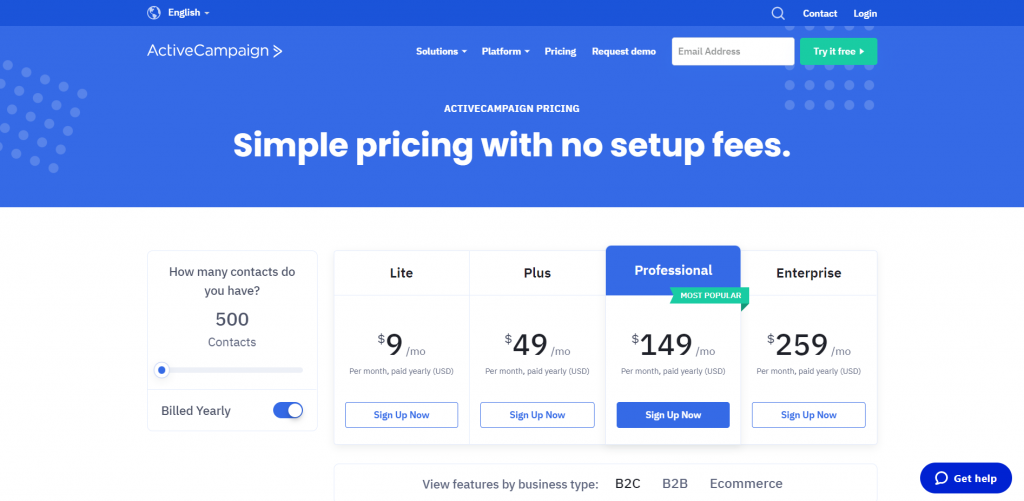ActiveCampaign vs. Mailchimp : Which One is Better for You
We get it – email marketing is an inalienable part of your online success. It plays a significant role in lead generation, brand awareness, customer retention, and many more digital marketing strategies.
However, at the same time, email marketing can be pretty challenging to execute. Imagine handling the subscriber list by hand? It will take you hours, if not days, to attend to each and every one of them. And here’s where automation becomes absolutely indispensable.
But the question remains – which tool should you use?
We went on a mission to create a series of articles to help you find the best email marketing platform for your needs. Today, we give the floor to ActiveCampaign and Mailchimp.
What is ActiveCampaign?
ActiveCampaign is an advanced digital marketing tool that is known for its customer experience automation (or, as they call it, CXA) features. ActiveCampaign has been in the email marketing scene since 2003 with over 130,000 companies from 170 countries using it for their digital marketing operations.
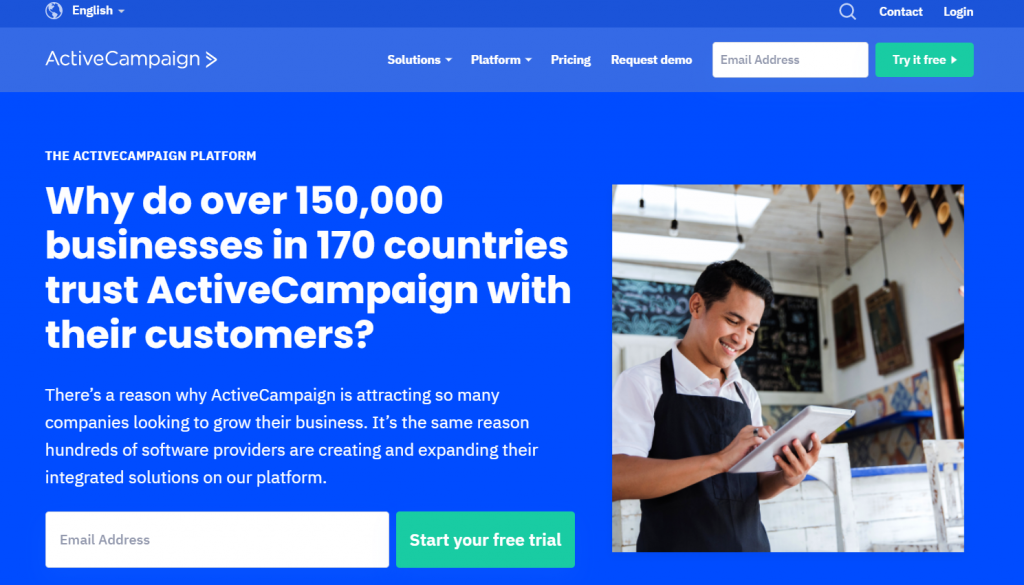
ActiveCampaign has a wide set of features and tools covering the entire sales funnel with features for nurturing, reaching, converting, and scaling leads and prospects. The channels covered include chat and text messaging, email, and social media.
With over 800 integrations, ActiveCampaign also makes sure that your work and data are seamlessly shared with the remaining tools and integrations you use.
Our first candidate is here. Let’s have an intro for the second one, Mailchimp, and get into the comparison.
What is Mailchimp?
Mailchimp is a multi-channel digital marketing platform. It began as an email marketing software at first, but has now expanded its scope to include advertising, social networks, and more.
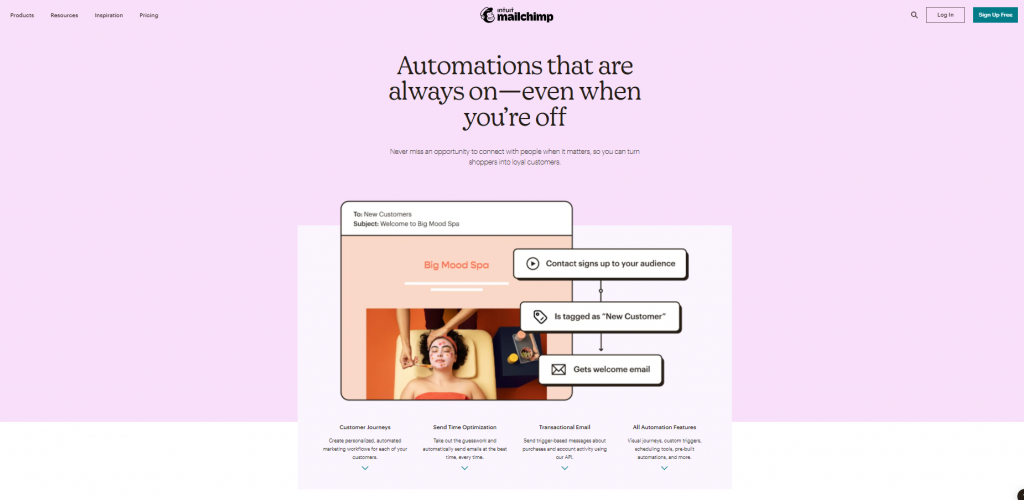
As of right now, Mailchimp holds around 2/3 of the email software market.
Among the features offered by Mailchimp, we can find its email templates builder, pop-up manager, form builder, segmentation, landing page builder, SMS marketing set, and others. Mailchimp is also known for its great customer success team.
Both our candidate email marketing tools are introduced. Now it is worth listing where they excel and which side of theirs needs improvement.
ActiveCampaign: Advantages and Disadvantages
ActiveCampaign is a service we need to take seriously. It has significant traction and growth with a $240 million investment raised last year.
The focus of ActiveCampaign is more on providing an A-Z solution with advanced features. This, of course, is both a pro and a con for its users. Here is what ActiveCampaign users say about the tool.
Advantage #1: Powerful tool with many useful features
ActiveCampaign is a great tool for those who look for advanced capabilities. Users can create marketing campaigns and automations with complex logic and workflows. It fits the needs of both B2B and B2C marketers, as you can separately manage business contacts and personal contacts. It has its own complete CRM that also involves your sales team and your sales process.

There are probably only a few email marketing features we can name that you cannot find in ActiveCampaign. For instance, it is the deliverability reports. But overall, ActiveCampaign is packed with features.
Advantage #2: Great customer service
ActiveCampaign also gets lots of positive reviews and praises for the quality of its customer service.

All the paid plans have both live chat and support over email. Contacting the support team is easy, as there is a special button for it in the main dashboard. There is also phone support if you have subscribed to the Enterprise plan.
Other than the direct contact support, ActiveCampaign also has a comprehensive knowledge center with lots of tutorials that you can open with the Help button on the page.
Disadvantage #1: Email campaign builder is powerful, but a bit hard to use
The drag-and-drop email campaign builder of ActiveCampaign follows the general rule too. The email editor has lots of features, but it is hard to learn and use.
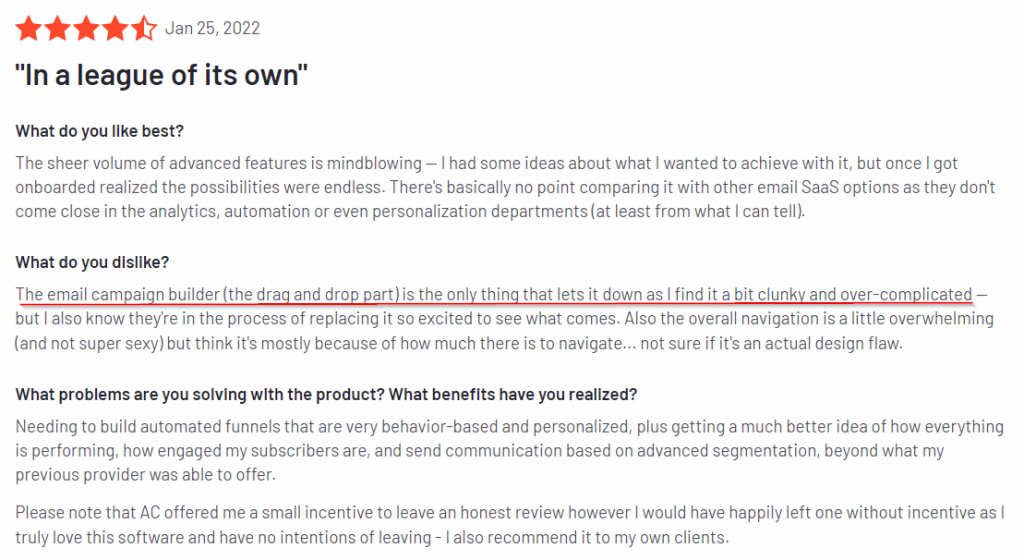
There are several types of email campaigns, multiple types of items you can place in an email, as well as a series of options to customize each item. All of this sounds cool until you try to use it and get lost in the abundance of options and features in the drag-and-drop editor.
Disadvantage #2: Learning curve in using the tool
ActiveCampaign is a great tool for advanced professionals. But for novices, there is a learning curve you need to go through to understand how everything works and how to use its features.

As ActiveCampaign has CRM and special features for sales teams, users point out that it is hard for them to learn and use these solutions without prior knowledge and experience in sales and marketing.
ActiveCampaign packs a punch with its tools. We wonder how Mailchimp stacks up against it.
Mailchimp: Advantages and Disadvantages
With so many individuals and companies using Mailchimp, it is natural that both its advantages and fallbacks are equally popular and widely discussed.
Let’s look at the most important of them.
Advantage #1: It’s a powerful marketing platform that offers lots of useful features
Although Mailchimp is not a customer experience automation platform like ActiveCampaign, its set of features is extensive, too. It helps you create great content with its smart suggestions, offers an advanced analytics suite to check and improve your campaigns, and helps you manage your contacts with a lightweight CRM.

Overall, the folks at Mailchimp have made sure that they have all the features that a business would need to drive its digital marketing operations.
Advantage #2: Users get high-quality customer support
Mailchimp has made a name for its quality customer support. They offer live chat and email support with an award-winning team behind it. That’s right, Mailchimp’s customer support team has gained 14 awards.
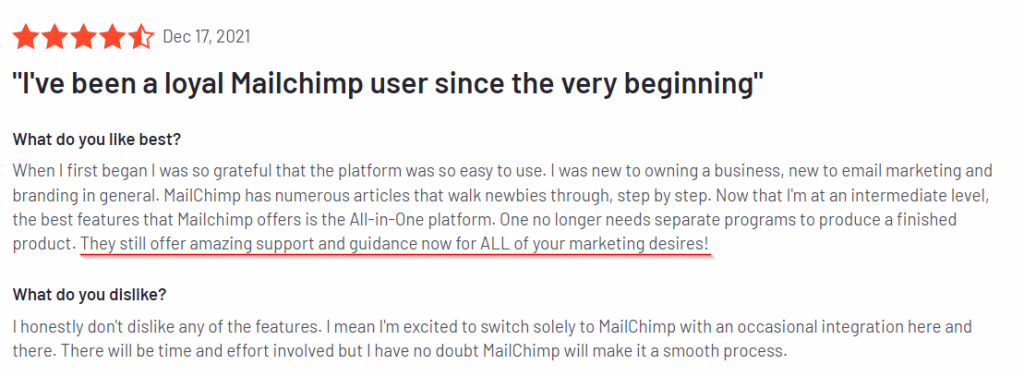
Other than that, Mailchimp offers a help center in multiple languages and a blog with lots of useful email marketing articles to improve your email marketing campaigns.
Disadvantage #1: Some features are hard to use
Just like ActiveCampaign, Mailchimp also offers lots of features. And just like its counterpart, it also has a problem with people getting lost in that abundance of tools and solutions.

A good example is Mailchimp’s settings section. The user above complains that, even though there are plenty of useful features and options you can use, they are hidden behind nested menus that make it hard to navigate and find what you are looking for.
There is inconsistency in the user interface as well, as some of the navigation is in the sidebar, rest is tabs or buttons elsewhere. All of it makes users even more confused.
Disadvantage #2: High costs
Mailchimp’s pricing depends on how many people have subscribed to your mailing list. The more subscribers, the more you pay. The problem here is that the number of subscribers and its growth are not directly under your control. So there is always a risk that you might end up paying more than you were expecting.

There is also feedback about the price gap between the plans. Users complain that prices can get significantly high if you are considering the upper pricing plans.
We hope that our list of advantages and disadvantages gives you a good overview of the tools, as it is time to dig into the details. We’ll start with features.
Comparison Point #1: Features
The main difference between ActiveCampaign and Mailchimp is how advanced their features are. ActiveCampaign offers lots of extra capabilities and intricate tools tailored for power users. Compared to ActiveCampaign, Mailchimp’s features are less advanced, but they are purpose-built for ease of use for everyone.
Both tools offer interesting features covering various areas of digital marketing. We have selected the most prominent ones for you here.
ActiveCampaign
ActiveCampaign feels like a power tool for users.

Here are four features in ActiveCampaign that we thought deserved special attention.
Feature #1: Split testing
The split or A/B testing feature at ActiveCampaign is quite capable.
The feature does not limit itself to A/B only, as you can test up to 5 versions of a message at once (you can call it an A/B/C/D/E testing).
And you are not limited to testing only the content either, as ActiveCampaign allows analyzing multiple aspects of your email content too. Here is what you can A/B test with this platform:
- Email subject lines.
- The content of the email.
- The “From” address.
- Your images and creatives.
- Your calls to action.
- Even whole emails.
ActiveCampaign also lets you split-test the whole automation or journey, not only a single email or campaign. Here’s what it looks like.

Besides, this email marketing solution lets you choose how to calculate the results and declare the winner. If you prefer clicks, choose them. Maybe you think that comparing by the open rate is better? You can choose that option as well.
Feature #2: CRM for sales and marketing
This is probably where ActiveCampaign stands out from its competition. It is a multi-functional CRM, both for the marketing and your sales teams. The CRM lets you manage your leads, automate them and handle all of your contacts.
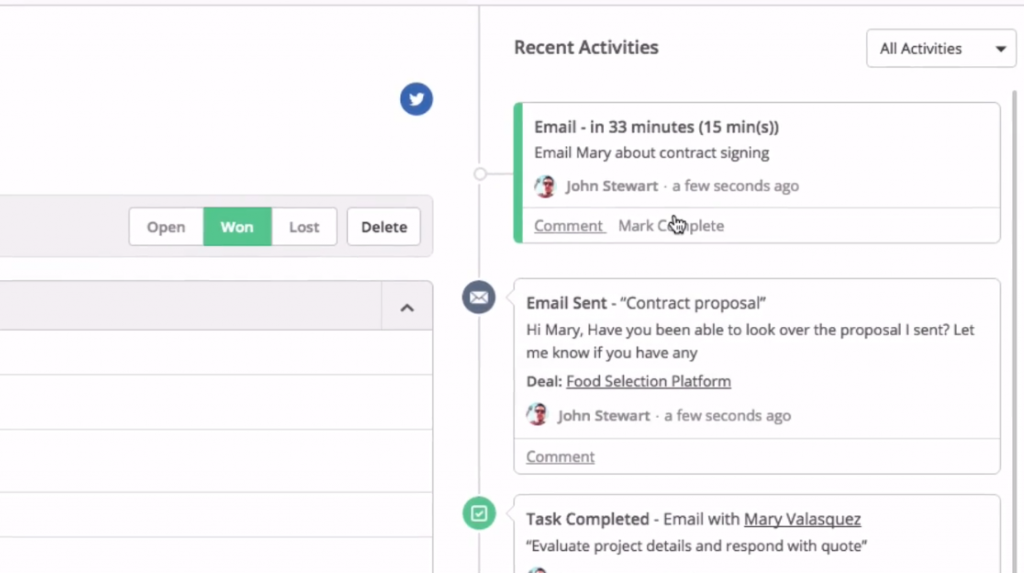
As on the screenshot above, there is also a comprehensive history of all interactions with your contact, including both tasks and messages.
Feature #3: Marketing automation
When speaking about an advanced tool, we assume its automation solutions include lots of features and abilities, right? We are correct on that with ActiveCampaign. Its marketing automation was built with multi-functionality in mind.
Here’s an example of automation workflow for recovering abandoned carts in a Shopify web store:

Other than abandoned carts, here are two other noticeable examples of email marketing automations that you can do with ActiveCampaign:
- Welcome email series, including onboarding emails or follow-ups to continue where they have left off.
- Give scores to contact every time they interact with you.
ActiveCampaign also lets you read information about subscribers from live chat, landing pages they have visited, and many other places.
Feature #4: Dynamic content
The abilities of ActiveCampaign’s Dynamic Content feature are impressive as well. It allows you to change email content based on the preferences of your subscribers.
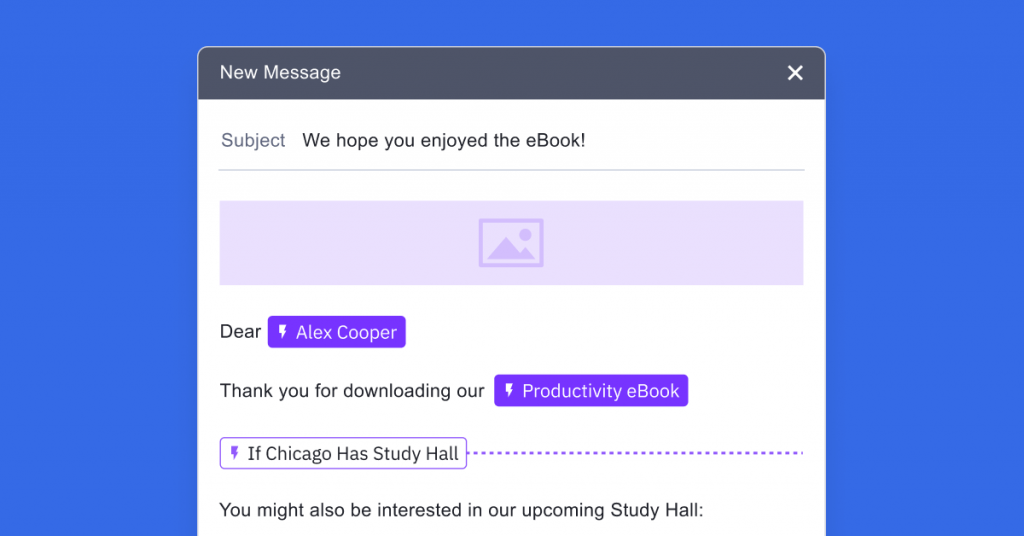
With its if/else blocks, you can also change entire sections of the email depending on a specific condition. In the example above, the second part of the email will only appear when the subscriber’s city has a study hall where your event is taking place.
The features offered by ActiveCampaign are impressive, but we should not underestimate Mailchimp though. It’s time to see what features it offers.
Mailchimp
Unlike ActiveCampaign, Mailchimp has not focused on providing advanced features for power users. Instead, their user-friendly interface and feature set fit well for everyone, from complete novices to expert marketers.
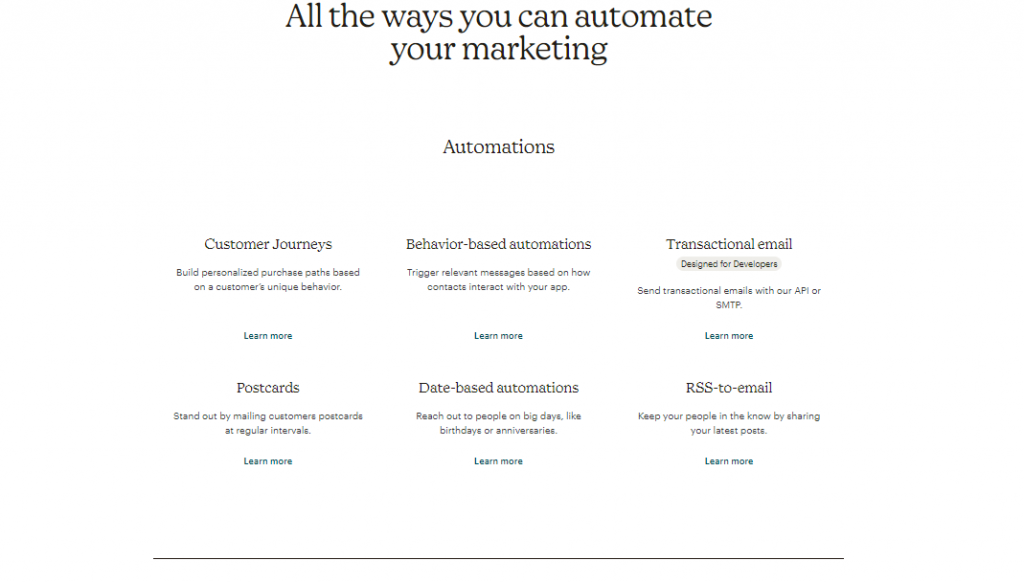
Having easy-to-use features does not mean that Mailchimp has less to offer though. Its functionality is impressive too.
Feature #1: A/B and multivariate testing
Mailchimp lets you test your emails, much like ActiveCampaign. A/B testing is a campaign type in the email builder. Just select it and choose the part of the email you want to test (for example, it can be your subject line or “from” name).

Mailchimp also lets you test 3 versions of an email simultaneously (a.k.a. A/B/C test). Its premium package includes multivariate testing that lets you check up to 8 variations of an email.
Feature #2: Marketing CRM
Although not a complete CRM tool, Mailchimp’s features for managing relationships with your subscribers and customers are quite impressive.
With the Marketing CRM, you get:
- Ability to connect other tools and bring customer data into the CRM.
- See insights on growth and conversion for both an individual and your whole audience.
- Pre-made segments tailored to your audience to save your time on analyzing data.
Mailchimp’s CRM is also available on its mobile app, allowing you to track and get an overview of your audience from anywhere.
Feature #3: Predicted demographics
That’s right, Mailchimp can predict demographic data for you. In particular, it can tell you the breakdown of your audience by age and gender.
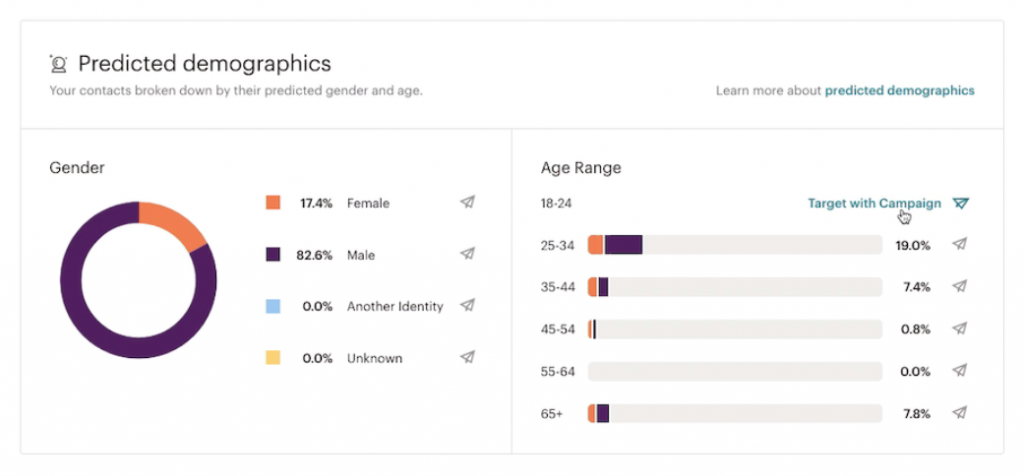
It can do the prediction even if your subscriber has not interacted with your campaigns yet. Mailchimp uses available data and special algorithms to understand the audiences of which gender and age have subscribed to your email lists.
Feature #4: Automated journeys
Mailchimp’s Automation feature lets you create a step-by-step journey for your subscribers and interact with them based on your requirements.

You can set to send an email after waiting for some time or after the subscriber has interacted with the previous email. There is a branching feature that lets you have two actions simultaneously. For instance, you can send email A when your subscriber has opened the previous email, or email B when they have ignored it.
ActiveCampaign and Mailchimp are different in terms of their features. ActiveCampaign is better when you need to set up advanced automations and logic. Mailchimp is best when you are new to the email marketing scene.
What about their analytics features? We have it covered for you, too.
Comparison Point #2: Analytics
Analytics is a key area for any digital marketing expert. Tracking your KPIs with a good analytics suite can bring lots of benefits.
Our candidates do not lack in this area. We will discuss and compare the analytics and reporting features for both of them, but you are to judge which one fits you best.
ActiveCampaign
ActiveCampaign takes data and reporting seriously. Its analytics and reporting section allows you to track:
- Campaign performance, including the number of sent messages, bounce rate, deliverability, open rate for each day, and even open rate per hour. The latter lets you analyze and find the best time of the day to send your campaigns.
- Real-time read and click performance, lead scoring, including data per individual campaign, and data for all of your campaigns together.
- Automations performance, including the number of interactions, number of completed automations, as well as your goals and their complete rate.
The reports feature also gives you interesting insights on your contacts, such as their number, growth rate, and trends.

ActiveCampaign offers more reports, such as form insights, tag trends, and many others.
Mailchimp
Mailchimp’s analytics set brings you a fair amount of insights too. It is capable of tracking and reporting:
- Overall statistics on all email, social, and advertising campaigns.
- Engagement metrics, such as clicks and open rates.
- Revenue statistics and trends.
- The most clicked areas of your emails using a heat map that highlights them on an email screenshot.
- Where your campaign performance stands when compared to others in your industry.
- Any custom fields you have set.
All the reporting is also available in the Mailchimp mobile app.

Mailchimp and ActiveCampaign both have a fair amount of reports and insights for you. So the choice is up to your specific needs. Now let’s move on to integrations.
Comparison Point #3: Integrations
The people in marketing use a pretty extensive stack of tools for their activities. Imagine how cumbersome it would be to manually move information from one tool to another. This is where integrations come into play.
Our candidate email marketing services both boast a big number of 3rd party tools and application integrations.
ActiveCampaign
There are over 850 tools that ActiveCampaign connects with. Among them you can find:
- E-Commerce Stores: Shopify, WooCommerce, eBay, Prestashop
- Forms: JotForm, Convert flow, Opt-in Panda.
- Analytics Tools: Google Analytics, Mixpanel, Segment, Wildmetrics, Zoho Metrics.
- Content Management Systems: Drupal, Joomla, WordPress, Squarespace, Webflow.
There is an app partner program that both helps and regulates the process of 3rd party companies creating plugins and integrations for ActiveCampaign.
There is also an API with its reference available for custom implementations of the ActiveCampaign integration.
Mailchimp
How about the integrations stack of Mailchimp? It is quite a wide net of 3rd party tools and popular platforms. Mailchimp’s number of integrations is in the thousands. Some popular tools are:
- Unsplash.
- Shopify.
- Canva.
- Photoshop.
- Stripe.
- Linkedin.
- QuickBooks.
- Facebook.
- Salesforce.
Thanks to its collaboration with Zapier, Mailchimp can connect with 3,000 more tools and apps. There is also the API with reference for custom tools and code implementations.
You don’t need to worry about integrations with your tools no matter which one of our contestants you choose – both have got you covered.
Comparison Point #4: Pricing
Sometimes, it is not the features, analytics, or integrations that drive your decision. Sometimes, your dealmaker and deal-breaker is pricing.
If compared side-by-side, ActiveCampaign and Mailchimp use similar pricing models and both provide a fair value for money. They have different tiers with varying features and prices that can increase for all plans depending on the size of your audience.
ActiveCampaign
ActiveCampaign pricing offers four subscription options with no free plan. All plans come with a free trial that lasts 14 days. You can get the cheapest option for just $9/month for 500 contacts and the Enterprise plan for $539/month for 10,000 contacts.
The pricing changes based on the number of contacts, too. Here are the maximum and minimum prices spending on your contacts:
- Lite: from $9 / 500 contacts to $549 / 100,000 contacts.
- Plus: from $49 / 500 contacts to $379 / 25,000 contacts.
- Professional: from $149 / 500 contacts to $549 / 25,000 contacts.
- Enterprise: from $259 / 500 contacts to $539 / 10,000 contacts.
All plans have a 15% discount if you are choosing the annual payment option.
Mailchimp
Mailchimp’s pricing is generally similar. There are different plans with increasingly more features and higher prices if your contact base is large.
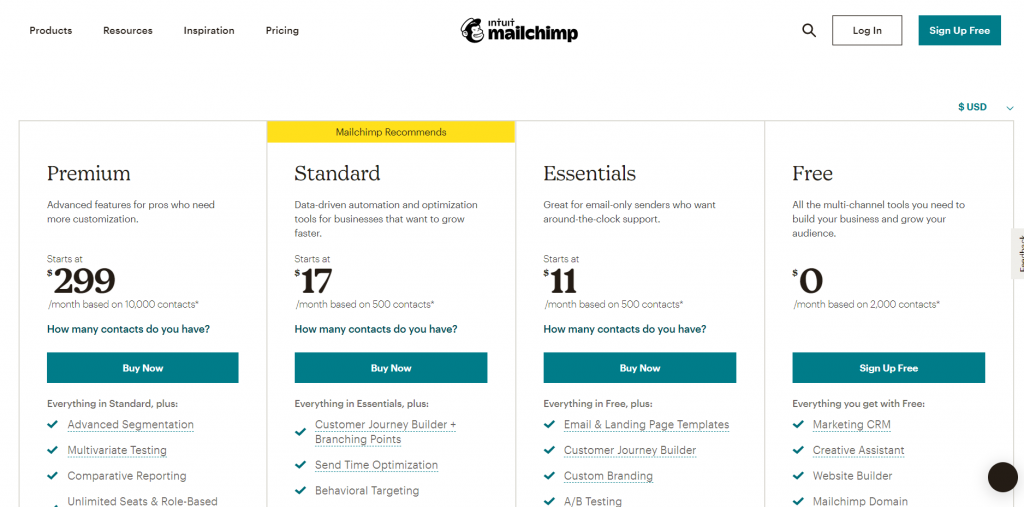
Unlike ActiveCampaign, Mailchimp has a free forever plan. However, the features are limited and you can have only 2,000 contacts with a mail send limit of 12,000/month.
Mailchimp’s prices, including their change for the number of subscribers, are:
- Essentials: from $11 / 500 contacts to $299 / 50,000 contacts.
- Standard: from $17 / 500 contacts to $605 / 100,000 contacts.
- Premium: from $299 / 10,000 contacts to $1300 / 200,000 contacts.
Now you know about the prices of our contestants too. Which one will you go for?
Now Over to You
Both ActiveCampaign and Mailchimp are excellent marketing tools. Go for the first one if advanced workflows and campaigns are your thing. If you prefer user-friendliness and thousands of integrations, then Mailchimp would be the better option for you.
We hope our guide has helped you decide. Have fun doing marketing!We have also compared Mailchimp to Campaign Monitor. Check that out as well. And, if you want to learn more about digital marketing in general, go over to our blog for more interesting guides and articles.
Frequently Asked Questions (FAQs)
Q1. Does ActiveCampaign integrate with Mailchimp?
ActiveCampaign does not directly integrate with Mailchimp. However, you can connect these two tools using Zapier as both of them are integrated with it. Zapier integration lets you synchronize data on new subscribers, contact updates, unsubscribes, automation data, and more.
Q2. What’s the difference between ActiveCampaign and Mailchimp?
The main difference between ActiveCampaign and Mailchimp is that the first one focuses on advanced features and targets power users, while the second one gives higher priority to the user-friendliness of its interface and makes sure that people of all backgrounds can easily use it.
Q3. What is the best email marketing company?
Some of the best email marketing companies are:
- HubSpot.
- Aweber.
- SendInBlue.
- Moosend.

Sona Kalantaryan is a senior digital marketer with a creative past. Big fan of high cinema and well-optimized landing pages. She authors guides by sharing the best practices and does it the right way!

